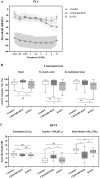A comparison between wireless CROS/BiCROS and soft-band BAHA for patients with unilateral hearing loss
- PMID: 30789931
- PMCID: PMC6383877
- DOI: 10.1371/journal.pone.0212503
A comparison between wireless CROS/BiCROS and soft-band BAHA for patients with unilateral hearing loss
Abstract
This study directly compared the performance of a contralateral routing of signal (CROS)/bilateral routing of signal (BiCROS) and a soft-band bone-anchored hearing aid (BAHA) in patients with unilateral sensorineural hearing loss (SNHL) and assessed the relationship between hearing aid benefits and personal factors. Participants with unilateral SNHL were prospectively enrolled in the study and were tested under the following three conditions: unaided, with CROS/BiCROS, and with soft-band BAHA. Sound localization, consonant, hearing in noise, and psychoacoustic tests were performed. Pseudobinaural benefits (e.g., squelch, summation, and head shadow effect) were obtained in both the CROS/BiCROS and soft-band BAHA conditions and compared to the unaided condition. Sound localization ability was not improved in either the CROS/BiCROS condition or soft-band BAHA condition. Rather, sound localization ability was significantly decreased in the CROS/BiCROS setting. A CROS/BiCROS hearing aid and a soft-band BAHA provided additional benefit for speech-in-noise perception when target speech was directed to the impaired ear side. The CROS/BiCROS hearing aid was superior to the soft-band BAHA one in decreasing the head shadow effect, but it appeared to have a negative effect when the noise was delivered to the better ear. The positive and negative effects of CROS/BiCROS for localization and speech perception were significantly correlated with personal factors such as age, hearing threshold in the better ear, and unaided psychoacoustic performances. Despite the lack of device acclimatization, we believe that this study provides counseling information for hearing aid clinics to use in the context of patients with unilateral SNHL.
Conflict of interest statement
The authors have declared that no competing interests exist.
Figures




Similar articles
-
Amplification in the rehabilitation of unilateral deafness: speech in noise and directional hearing effects with bone-anchored hearing and contralateral routing of signal amplification.Otol Neurotol. 2006 Feb;27(2):172-82. doi: 10.1097/01.mao.0000196421.30275.73. Otol Neurotol. 2006. PMID: 16436986
-
Subjective and objective outcomes from new BiCROS technology in a veteran sample.J Am Acad Audiol. 2012 Nov-Dec;23(10):789-806. doi: 10.3766/jaaa.23.10.5. J Am Acad Audiol. 2012. PMID: 23169196 Clinical Trial.
-
Sentence recognition in noise and perceived benefit of noise reduction on the receiver and transmitter sides of a BICROS hearing aid.J Am Acad Audiol. 2013 Nov-Dec;24(10):980-91. doi: 10.3766/jaaa.24.10.9. J Am Acad Audiol. 2013. PMID: 24384083 Clinical Trial.
-
The evidence base for the application of contralateral bone anchored hearing aids in acquired unilateral sensorineural hearing loss in adults.Clin Otolaryngol. 2006 Feb;31(1):6-14. doi: 10.1111/j.1749-4486.2006.01137.x. Clin Otolaryngol. 2006. PMID: 16441794 Review.
-
Candidacy for the bone-anchored hearing aid.Audiol Neurootol. 2004 Jul-Aug;9(4):190-6. doi: 10.1159/000078388. Audiol Neurootol. 2004. PMID: 15205546 Review.
Cited by
-
Factors Influencing Intentions of People with Hearing Impairments to Use Augmented Reality Glasses as Hearing Aids.Behav Sci (Basel). 2024 Aug 21;14(8):728. doi: 10.3390/bs14080728. Behav Sci (Basel). 2024. PMID: 39199124 Free PMC article.
-
Conversations in Cochlear Implantation: The Inner Ear Therapy of Today.Biomolecules. 2022 Apr 29;12(5):649. doi: 10.3390/biom12050649. Biomolecules. 2022. PMID: 35625577 Free PMC article. Review.
-
Systematic review of outcome domains and instruments used in designs of clinical trials for interventions that seek to restore bilateral and binaural hearing in adults with unilateral severe to profound sensorineural hearing loss ('single-sided deafness').Trials. 2021 Mar 20;22(1):220. doi: 10.1186/s13063-021-05160-5. Trials. 2021. PMID: 33743802 Free PMC article.
-
An Epidemiological Study of Hearing Loss in a Peripheral Tertiary Care Hospital.Indian J Otolaryngol Head Neck Surg. 2022 Dec;74(Suppl 3):4264-4269. doi: 10.1007/s12070-021-02934-w. Epub 2021 Oct 23. Indian J Otolaryngol Head Neck Surg. 2022. PMID: 36742821 Free PMC article.
-
Correlation of cochlear aperture stenosis with cochlear nerve deficiency in congenital unilateral hearing loss and prognostic relevance for cochlear implantation.Sci Rep. 2021 Feb 8;11(1):3338. doi: 10.1038/s41598-021-82818-9. Sci Rep. 2021. PMID: 33558599 Free PMC article. Clinical Trial.
References
-
- Sargent EW, Herrmann B, Hollenbeak CS, Bankaitis AE. The minimum speech test battery in profound unilateral hearing loss. Otol Neurotol. 2001;22(4):480–6. . - PubMed
-
- Silverman CA, Silman S, Emmer MB, Schoepflin JR, Lutolf JJ. Auditory deprivation in adults with asymmetric, sensorineural hearing impairment. J Am Acad Audiol. 2006;17(10):747–62. . - PubMed
-
- Killion MC, Niquette PA, Gudmundsen GI, Revit LJ, Banerjee S. Development of a quick speech-in-noise test for measuring signal-to-noise ratio loss in normal-hearing and hearing-impaired listeners. J Acoust Soc Am. 2004;116(4 Pt 1):2395–405. . - PubMed
Publication types
MeSH terms
LinkOut - more resources
Full Text Sources
Medical

